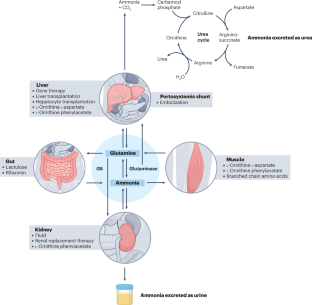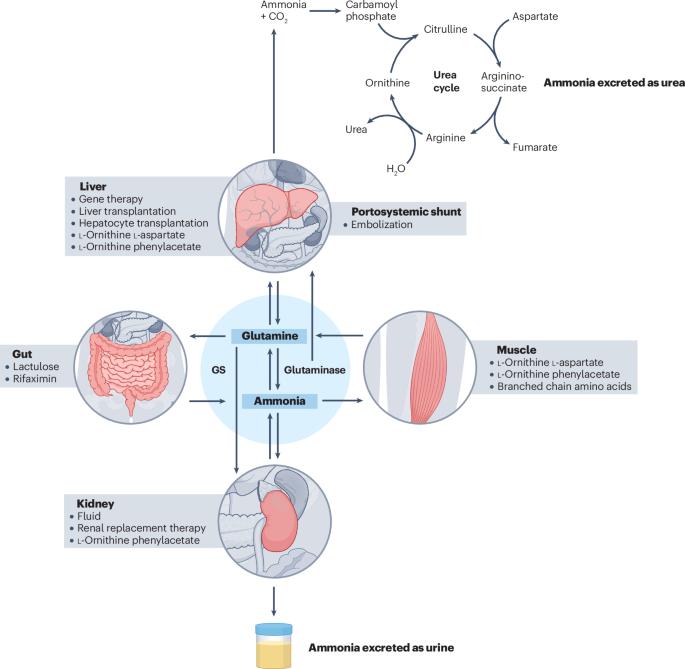Ammonia-induced stress response in liver disease progression and hepatic encephalopathy
IF 45.9
1区 医学
Q1 GASTROENTEROLOGY & HEPATOLOGY
引用次数: 0
Abstract
Ammonia levels are orchestrated by a series of complex interrelated pathways in which the urea cycle has a central role. Liver dysfunction leads to an accumulation of ammonia, which is toxic and is strongly associated with disruption of potassium homeostasis, mitochondrial dysfunction, oxidative stress, inflammation, hypoxaemia and dysregulation of neurotransmission. Hyperammonaemia is a hallmark of hepatic encephalopathy and has been strongly associated with liver-related outcomes in patients with cirrhosis and liver failure. In addition to the established role of ammonia as a neurotoxin in the pathogenesis of hepatic encephalopathy, an increasing number of studies suggest that it can lead to hepatic fibrosis progression, sarcopenia, immune dysfunction and cancer. However, elevated systemic ammonia levels are uncommon in patients with metabolic dysfunction-associated steatotic liver disease. A clear causal relationship between ammonia-induced immune dysfunction and risk of infection has not yet been definitively proven. In this Review, we discuss the mechanisms by which ammonia produces its diverse deleterious effects and their clinical relevance in liver diseases, the importance of measuring ammonia levels for the diagnosis of hepatic encephalopathy, the prognosis of patients with cirrhosis and liver failure, and how our knowledge of inter-organ ammonia metabolism is leading to the development of novel therapeutic approaches. This Review describes inter-organ ammonia metabolism in liver disease and mechanisms underlying the pathogenic effect of hyperammonaemia in hepatic encephalopathy, liver disease progression in metabolic dysfunction-associated steatotic liver disease, immune dysfunction and hepatocellular carcinoma. It also addresses the principles of treating hyperammonaemia.


肝病进展和肝性脑病中氨诱导的应激反应
氨水平由一系列复杂的相互关联的途径协调,其中尿素循环起着核心作用。肝功能异常会导致氨积累,氨具有毒性,与钾平衡紊乱、线粒体功能障碍、氧化应激、炎症、低氧血症和神经传递失调密切相关。高氨血症是肝性脑病的标志,与肝硬化和肝衰竭患者的肝脏相关结果密切相关。除了氨作为神经毒素在肝性脑病发病机制中的既定作用外,越来越多的研究表明,氨可导致肝纤维化进展、肌肉疏松症、免疫功能障碍和癌症。然而,在代谢功能障碍相关脂肪性肝病患者中,全身氨水平升高的情况并不常见。氨引起的免疫功能障碍与感染风险之间的明确因果关系尚未得到明确证实。在这篇综述中,我们将讨论氨产生各种有害影响的机制及其在肝病中的临床意义、测量氨水平对诊断肝性脑病的重要性、肝硬化和肝衰竭患者的预后,以及我们对器官间氨代谢的了解如何促进新型治疗方法的开发。
本文章由计算机程序翻译,如有差异,请以英文原文为准。
求助全文
约1分钟内获得全文
求助全文
来源期刊
CiteScore
52.30
自引率
0.60%
发文量
147
审稿时长
6-12 weeks
期刊介绍:
Nature Reviews Gastroenterology & Hepatology aims to serve as the leading resource for Reviews and commentaries within the scientific and medical communities it caters to. The journal strives to maintain authority, accessibility, and clarity in its published articles, which are complemented by easily understandable figures, tables, and other display items. Dedicated to providing exceptional service to authors, referees, and readers, the editorial team works diligently to maximize the usefulness and impact of each publication.
The journal encompasses a wide range of content types, including Research Highlights, News & Views, Comments, Reviews, Perspectives, and Consensus Statements, all pertinent to gastroenterologists and hepatologists. With its broad scope, Nature Reviews Gastroenterology & Hepatology ensures that its articles reach a diverse audience, aiming for the widest possible dissemination of valuable information.
Nature Reviews Gastroenterology & Hepatology is part of the Nature Reviews portfolio of journals.

 求助内容:
求助内容: 应助结果提醒方式:
应助结果提醒方式:


